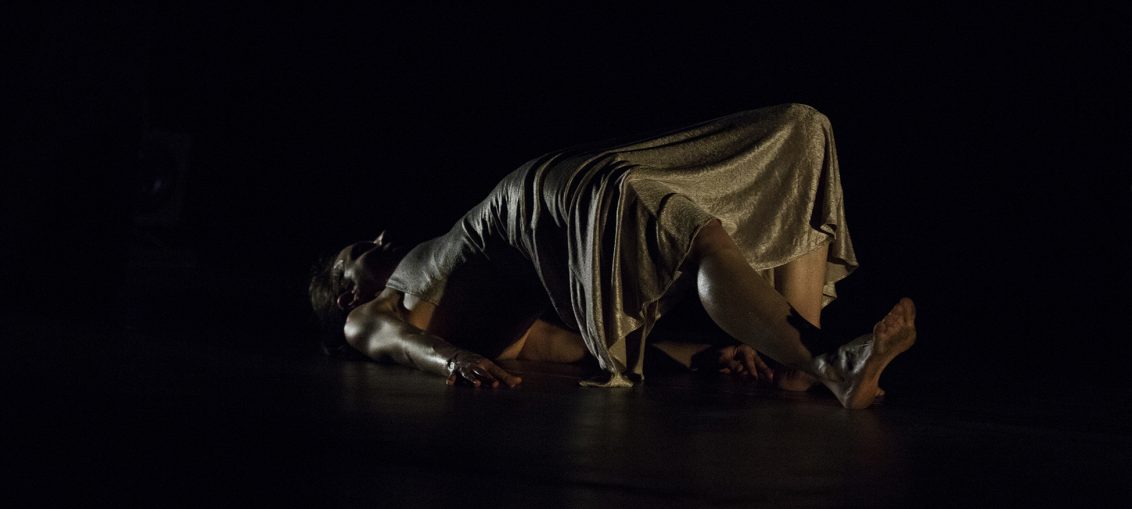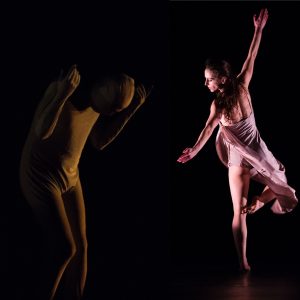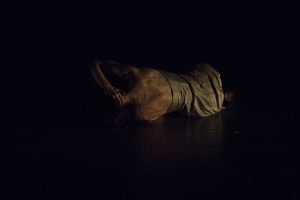

The opening weekend of the acclaimed La MaMa Moves! Dance Festival featured the only two headlining works which would perform at the Ellen Stewart Theater — an intimidating space for such intimate dance pieces. One, Lucie Grégoire Danse Company’s Les Choses Dernières: the New York premiere of a solo work made famous by the Montreal-based choreographer, now passed on to another dancer, and the other, Egyptian creator/performer Adham Hafez and HaRaKa Platform’s To Catch A Terrorist: a world-premiere of a new work and collaborative effort that utilizes spoken word as much as body language. Both explored disturbing topics that are current, timeless and poignant — one by playing with words and gestures to make their statement, and the other, inspired by an author’s words, which were expressed solely through the vessel of the dancer. Each one filled the vast theater and utterly captivated the attention of all present.
Les Choses Dernières (The Last Things) is inspired by Paul Auster’s In the Country of Last Things, of which the first 40 pages so troubled, overwhelmed and affected choreographer Lucie Grégoire, that she had to put the book down… then immediately get to work in the studio once she resumed and finished it.
Auster’s deeply unnerving epistolary novel follows the protagonist Anna Blum e through a series of letters as she enters into an unnamed city, in search of her brother, that has collapsed into a shamble of chaos and disarray. In this dismal abyss, no industry occurs and most of the citizens have been reduced to garbage scavengers hunting for objects to resell. The disquieting piece has inspired many retellings, each unique, including a production in Sarajevo, during the siege, which was later sponsored and toured by Peter Brook. Auster chose a woman as the narrator because, “Women are the best and only reliable witnesses of historical events,” and further asserts, “This is not a dystopian novel, but a realistic portrayal of historical fiction,” noting places where the atrocities mentioned in the book actually have and do happen (the garbage collecting was practiced in Egypt, which Hafez and company attested). Grégoire’s interpretation uses only one dancer, herself initially, though she has since passed the work on to three others to recreate, including the astonishing Kim Henry, who performed it that evening, with author Paul Auster in attendance, viewing the piece live for the first time.

Henry’s embodiment of Anna Blume’s desolate situation, as told through Grégoire’s relentless, athletically-abusive choreography, evokes the great Pina Bausch at the height of her glory in The Rite of Spring’s merciless, unflinching motion or Café Müller’s remorseless purgatorial repetition — only those pieces had a company of dancers. In Les Choses Dernières, there is but one to bear the hour-long burden themselves. Perhaps it’s no surprise that Ms. Henry, clad in a silken dress by Angelo Barsetti (not unlike something Pina might have chosen), began her career as a gymnast. This piece, which Henry considered “a privilege to perform,” requires serious training and preparation for the body and mind. The movement, cast in cinematic lighting by Alain Lortie, recreated by Marc Parent, is vigorous and frenetic, like a madwoman possessed, then alternatingly strict, though more like being controlled than in control of oneself. Robert M. Lapage’s magnificent score, a true work of collaboration between he and Grégoire, features a string quartet whose sounds seem to be pulling the dancer like a puppet on a string, without dominion of her own destiny. There are animalistic, inhuman movements, like a broken-winged bird, galloping horse, or crab in disharmony with its sense of direction. But the most disquieting of all is when Ms. Henry crawls across the stage floor without use of her limbs, like a worm. In any expression and interpretation, Auster’s novel is a heroic demonstration of human survival after all recognizable humanity is broken down.
The second premiere, Adham Hafez’s To Catch A Terrorist is a rich, complex, alternatingly humorous and unsettling interrogation of what “Arabness” is and an examination of the visibility and invisibility of Arabic culture and its people.
Like his 2065 BC, performed at New York Live Arts 2016 Live Ideas Festival: MENA/Future, Adham Hafez’s new work combines movement, gesture, spoken word and multimedia elements to present a non-linear, non-traditional approach to a “dance” piece. This non-conforming path seems to be the road more taken at this year’s La MaMa Moves! Festival, according to curator Nicky Paraiso, which tackles hot-button subjects such as race, gender, exclusion, seeking inclusion and articulating what living on the margins truly looks and feels like.
To Catch A Terrorist begins on a dimly-lit stage with two microphones standing erect as if being interrogated while the voiceovers heard above, in several languages, set the discontent tone of the piece and the express separateness placed on Arabic people in the Western World. Suddenly, the stage goes black and there’s a scuffling in the darkness. And then, just darkness… for an uncomfortable length of time.
Making the audience squirm a bit is a signature move of Hafez’s in order to bring the viewer viscerally into the world of the disturbing subjects he explores. But just as the unsettling feeling settles in, like any good showman, he flips the script and lightens the mood with humor and satire.
Two officials enter from the wings (Adam Kucharski and Manar Abdelmaaboud, both with deadpan commitment) and set up a laptop and outdated projector. Next, renowned and respected Trisha Brown Company dancer and teacher, Iréne Hultman, is called upon as an “expert consultant” for the crime scene committed (that shuffling in the dark) clearly by an Arab based on the marks made by his dance moves.

What ensues is a laugh-out-loud hilarious exploration and satirical exploitation of “Arabness,” complete with projected slides of Disney’s Aladdin, Jafar and Princess Jasmine, Hultman’s hysterical enactment of Arabic dances (as well as Western dances for contrast and comparison) and text from real U.S. court immigration and citizenship hearing documents from 1880-1940, all entered in as “evidence.” Acclaimed dancers are not often granted speaking roles, but if they are as charmingly irreverent and comedically brilliant as Hultman, they should be. When the court is “satisfied,” they exit.
The stage fades to black again and an ambient hum, not unlike the disquieting buzzing of fluorescent lights (composed by Adham Hafez and Nadar Hafez), permeates the room before a soft illumination (expertly designed by Marie Yokoyama) reveals a faceless figure moving slowly and laboriously through the darkness as if through water. This is Hafez himself, covered head to toe in a bodysuit which seems to almost glow faintly under the low lighting and masks any features, emotions or recognizable human qualities.
He concludes the fluid movements with a lamentful, operatic contratenor wail. This is the “invisible man,” and the culprit they were after. The visual effect is indeed quite terrifying to observe emerging from the darkness without the comfort of a relatable human visage, thus confirming Hafez’s point of fearing the unknown: what we cannot see, wish to ignore and/or do not understand.
La MaMa Moves! Dance Festival runs from May 10-June 3, 2018 at La MaMa Experimental Theater Club, 66 East 4th Street, at the Ellen Stewart Theater: 2nd floor, and The Downstairs, basement level. For tickets and more information, visit www.lamama.org or call 212-352-3101.
 Tuesday, January 6, 2026
Tuesday, January 6, 2026